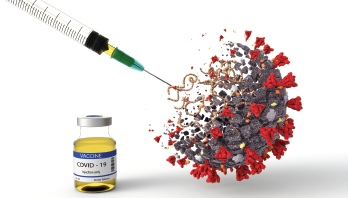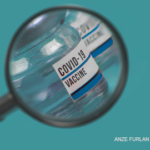
Orpheus FX / shutterstock.com
On April 5, 1950, a small group of scientists met in Silver Spring, Md., to talk about geophysics.
I know this is not the most riveting way to start, but if you stick with me, I promise the story will get much more interesting.
This group of scientists met to discuss all that was still not understood about the Earth. Together, they realized technology had finally reached the point at which important questions regarding planetary sciences could be tackled.
This meeting led to the International Geophysical Year, a multi-national scientific collaboration that would start on July 1, 1957, to coincide with peak sunspot activity, so scientists could examine the impact of solar activity on the Earth.1
I know, I know. Stick with me.
The International Council of Scientific Unions spent seven years planning experiments that would be conducted by 67 countries in more than 4,000 research stations worldwide. The careful planning was warranted because the International Geophysical Year was intended to bring the Cold War to an end.
The years following the end of World War II were characterized by a lack of international scientific exchange, particularly between the U.S. and the Soviet Union. The International Geophysical Year was meant to break the ice and usher in a new era of international collaboration.
And then the politicians got involved.
In 1955, the U.S. had announced its intent to launch an artificial satellite, ostensibly to celebrate the International Geophysical Year. Not to be outdone, four days later, the Soviet Union announced that it, too, would launch an artificial satellite, also to honor the multi-national scientific collaboration. Unlike the U.S., however, the Soviet Union actually did it.
On Oct. 4, 1957, the Soviet Union launched Sputnik 1, the first man-made satellite to orbit the Earth. Four months later, the U.S. achieved the same landmark, but it was undeniable: the Soviet Union got there first.2
Don’t look now, but Sputnik has beaten us again.
On Aug. 11, 2020, President Vladimir Putin of Russia introduced the world to Sputnik V—not a satellite, but an adenovirus-based vaccine he proclaimed was the first effective defense against SARS-CoV-2. The Russian Health Ministry announced plans to start vaccinating health workers and teachers, followed by the general population, this fall. Millions of doses of the vaccine are being prepared, many of which have already been sold to other nations.3 Meanwhile, the closest competitors are still in clinical trials. What do we know about this vaccine, and more importantly, how did the Russians reach the finish line first?
Phases of Vaccine Development
First, for those of you who need a refresher, not all clinical trials are created equal. As you can imagine, it would be difficult to justify the time or expense associated with giving an experimental therapy to tens of thousands of patients unless there was good reason to believe that it might actually work. For that reason, clinical trials occur in phases:4
- Phase 1 trials typically involve fewer than 100 subjects. These are the first studies that involve giving an investigational agent to people. Phase 1 trials are typically dose-ranging studies, in which healthy volunteers are given varying amounts of the new drug. These studies focus on safety. Agents that seem promising in a test tube or in mice may have side effects that may prevent them from ever becoming a marketable drug.
- Phase 2 trials typically include 100–300 subjects. These are the first studies that involve giving the investigational agent to patients. Not all of us are healthy 22-year-olds; an agent that seems to be well tolerated in a healthy volunteer may be problematic in a patient with the disease of interest. These studies also give us our first chance to see if the agent may benefit patients, although the trials are typically too small to be definitive.
- Phase 3 trials determine which drugs go to market. These studies, which can involve thousands of patients, are used to show a new drug actually leads to better outcomes for patients with the disease of interest.
- Phase 4 trials involve post-marketing surveillance to determine if a drug still seems to be safe after people start taking it on a regular basis. The U.S. Food & Drug Administration (FDA) sometimes requires pharmacovigilance studies as part of its approval process.
At each phase, approximately one-third of agents fail to make it to the next step. Statistically, this means if a company starts phase 1 studies on 100 agents, only 19 have a chance of becoming a marketable drug.5 And that’s even before we start to consider non-scientific questions, such as market share, which will determine whether it’s worthwhile for a pharmaceutical company to try to get FDA approval. These statistics also don’t acknowledge the drugs that reach the end of the gauntlet only to have approval taken away during post-marketing surveillance.
As a young physician, I prescribed ticlopidine and trovafloxacin, and had samples of rofecoxib in my desk. None of these drugs exist anymore, because of problems discovered in phase 4 studies.
All of these issues affect the cost of bringing a drug to market. A phase 3, placebo-controlled trial costs, on average, $35.1 million.6 The average cost of bringing a new drug to market is $2.6 billion when you factor in the time costs, which is the amount of money a drug company loses by using its time to conduct research rather than just selling previously approved drugs more aggressively.7
When you think about it that way, it’s no wonder we have multiple versions of statins and Viagra, but haven’t discovered a new class of antibiotics since 1987.8 Working on a completely novel drug just costs too much money.
Of course, with COVID-19, we don’t have a choice. Given the stakes, and the potential market size, it’s not at all surprising that more than 200 vaccines are currently in development for SARS-CoV-2. Of these, the vast majority are still in pre-clinical development. Only 34 vaccines are in clinical trials; only nine are in phase 3 studies.9
Notably, Sputnik V has just started phase 3 testing. From what has been described by the Russian government, Sputnik V has completed only what we would consider a phase 1 clinical trial: The vaccine was administered to healthy patients and didn’t seem to make anyone sick. That’s it. And while the phase 1 study indicates the vaccine can induce an antibody response, the Russians have skipped an important step: The vaccine is being distributed without any actual proof it will work clinically to prevent disease transmission.10
That leaves us with seven vaccines, currently in phase 3 clinical trials, that provide us with our best hope of having a vaccine in hand by 2021. What do we know about these vaccines, and which are the most promising?
Vaccines 101
Chicken farms are a key component of our national security strategy. Scattered across the U.S. in top secret locations, chickens are being guarded by the federal government.
I wish I were kidding.
In 2001, during an avian flu scare, the federal government came to the uncomfortable realization that we had no domestic source of influenza vaccine. Routine, childhood vaccines have a predictable market, but there’s no money to be made in preparing for an influenza pandemic that may not come. So the federal government stepped in. In an influenza pandemic, we would need 900,000 eggs daily for six to nine months to incubate an adequate amount of vaccine. Thanks to these secret chicken farms—the exact number is also a secret—we are well prepared.
I mention this only to illustrate that most of our vaccines are based on ancient technology. Influenza vaccine, for example, is created every year by injecting chicken eggs, one by one, with a live virus. Measles and mumps vaccines are also created using chicken eggs. Rick Bright, director of the Biomedical Advanced Research and Development Authority, which coordinates our response to biological threats, notes that “it is a shockingly fragile, delicate, expensive process.”11
It is also time consuming. For each new strain of influenza, it takes six months for the vaccine to become available.12 And that’s when we know what we are doing. For most viruses, developing a new vaccine takes 10 years or longer.
Older technologies—which were used to develop the live-attenuated and inactivated vaccines you received as a child—depend on growing a whole virus. This takes time. Newer technologies take a shortcut: They focus on generating just a fragment of the virus, just enough to teach your immune system what the virus looks like.
Most of these new vaccines hijack your own cells to do the heavy lifting. Instead of generating viral particles in a test tube (or a chicken egg), newer vaccines simply deliver the genetic material of the relevant fragment to the patient. The patient’s own cells then use that blueprint to generate the viral fragment, which teaches the patient’s immune system how to recognize the virus when it comes around.
The most promising vaccines against SARS-CoV-2 use one of two different strategies:
- Nucleic acid vaccines are primarily composed of strands of RNA, coated by a lipid shell that helps them gain entry into a cell.13 The vaccine being developed by Moderna (in collaboration with the National Institutes of Health) and by Pfizer are both nucleic acid vaccines.
- Viral-vectored vaccines reprogram a virus to deliver a fragment of another virus’ DNA into a cell.14 The vaccines being developed by AstraZeneca, Janssen and both the Russian and Chinese governments fall in this category.
Both strategies are considerably faster than the chicken egg-based strategy. The disadvantage? These strategies have never successfully led to the creation of a human vaccine.
Viral-vectored vaccines are particularly problematic, because the virus used to ferry the DNA may itself induce an immune response if the patient has seen it before. So, for example, if an adenovirus is used as the vector for SARS-CoV-2 DNA and the patient has had an adenovirus-mediated common cold, then the vaccine may be destroyed by the patient’s immune system before it has a chance to deliver the goods.
Worse, clinical effectiveness is not the highest hurdle for a new vaccine. The Lyme disease vaccine is the object lesson.
If you didn’t know we have a vaccine for Lyme disease, you shouldn’t feel bad, because we don’t. In 1998, the FDA approved a Lyme disease vaccine, which was 80% effective in preventing new infections. By 2001, however, the vaccine was taken off the market. In between came the vaccine victims, who claimed a wide range of vaccine-related side effects, especially musculoskeletal complaints. In retrospect, these complaints were no different from the complaints associated with any vaccine.
Before the vaccine was taken off the market in the U.S., more than 1.4 million doses were delivered. The Vaccine Adverse Event Reporting System (VAERS) recorded 905 reports of mild, self-limited reactions and 59 reports of arthritis, which is considerably less than the annual incidence of rheumatoid arthritis in an analogous population.
A second FDA review confirmed the vaccine was effective, and the rate of adverse events was not unusual.
By that time, however, the damage was done. A combination of breathless news articles and a class-action lawsuit caused demand for the vaccine to plunge, and GlaxoSmithKline voluntarily pulled the vaccine from the market. A good vaccine was defeated by bad press.15
Epilogue
The launch of Sputnik I was the beginning of the Space Race, but not the end. That came on June 20, 1969, when Neil Armstrong exited Apollo 11 and walked across the surface of the moon. John F. Kennedy announced the goal of reaching the moon in a speech delivered at Rice University, where he said we needed to set goals “not because they are easy, but because they are hard, because that goal will serve to organize and measure the best of our energies and skills … .”16
President Kennedy was probably thinking about Sputnik I, but his words are also an appropriate response to Sputnik V. In developing a vaccine to SARS-CoV-2, we need to embrace the challenge of doing something hard. There have already been calls to make vaccines widely available based on early data, because the need is great. We must resist. The public will give us one shot to get this right, and we must not squander it.
In the multi-billion dollar world of vaccine development, the most valuable commodity is the public’s trust. Even the best vaccine is useless if everyone refuses to take it.
In the multi-billion dollar world of vaccine development, the most valuable commodity is the public’s trust. Even the best vaccine is useless if everyone refuses to take it. In a recent survey, only 65% of people indicated a willingness to take a SARS-CoV-2 vaccine when it comes to market.17 To achieve herd immunity, we would need 80–90% of people to be vaccinated.18
To achieve that goal, the rollout of the SARS CoV-2 vaccine will have to be flawless. If we introduce a vaccine that is ineffective or has unanticipated side effects, public interest in a second vaccine will plummet. We need to employ all of our energies and skills to do this correctly, because we won’t get a second chance.
With this in mind, on Sept. 8, nine pharmaceutical companies pledged they would not bring a SARS Co-V-2 vaccine to market until phase 3 testing had been completed. One major company declined to sign the pledge; ironically, that company now has the distinction of being the first to temporarily pause its vaccine trial to investigate a serious adverse event. The pause was great news, actually; the company’s willingness to place the trial on hold indicates the system is working exactly as it should, with a priority placed on safety.
U.S. Department of Health & Human Services Secretary Alex Azar may have put it best: “The point is not to be first with a vaccine. The point is to have a vaccine that is safe and effective for the American people and the people of the world.”19
 Philip Seo, MD, MHS, is an associate professor of medicine at the Johns Hopkins University School of Medicine, Baltimore. He is director of both the Johns Hopkins Vasculitis Center and the Johns Hopkins Rheumatology Fellowship Program.
Philip Seo, MD, MHS, is an associate professor of medicine at the Johns Hopkins University School of Medicine, Baltimore. He is director of both the Johns Hopkins Vasculitis Center and the Johns Hopkins Rheumatology Fellowship Program.
References
- Rockets, radar, and computers: The International Geophysical Year. NOAA celebrates 200 years of science, service, and stewardship. National Ocean Service, National Oceanic and Atmospheric Administration, U.S. Department of Commerce. 2017 May 12.
- Wallace T. How Sputnik 1 launched the space age. Cosmos Magazine. 2017 Oct 3.
- Sputnik V: What we know about Russia’s coronavirus vaccine. Aljazeera. 2020 Aug 13.
- Phases of clinical trials. National Comprehensive Cancer Network.
- Hong CH, Siah KW, Lo AW. Estimation of clinical trial success rates and related parameters. Biostatistics. 2019 Apr;20(2):273–286.
- Moore TJ, Zhang H, Anderson G, et al. Estimated costs of pivotal trials for novel therapeutic agents approved by the US Food and Drug Administration 2015–2016. JAMA Intern Med. 2018 Mov 1;178(11):1451–1457.
- Sullivan T. A tough road: Cost to develop one new drug is $2.6 billion; approval rate for drugs entering clinical development is less than 12%. Policy & Medicine. 2019 Mar 21.
- Theuretzbacher U. Recent FDA antibiotic approvals: Good news and bad news. The Center for Disease Dynamics, Economics & Policy. 2015 Mar 12.
- Steckelberg A, Johnson CY, Florit G, Alcantara C. These are the top coronavirus vaccines to watch. The Washington Post. 2020 Aug 24 (updated Sep 8).
- Akpan N. Fauci “seriously doubts” the Russia vaccine is ready for widespread use. National Geographic. 2020 Aug 11.
- Aronczyk A, Gonzalez S. Where’s the vaccine? NPR. 2020 Mar 6.
- Pandemic influenza vaccine manufacturing process and timeline. Pandemic (H1N1) 2009 briefing note 7. World Health Organization. 2009 Aug 6.
- Restifo NP, Ying H, Hwang L, Leitner WW. The promise of nucleic acid vaccines. Gene Ther. 2000 Jan;7(2):89–92.
- Ura T, Okuda K, Shimada M. Developments in viral vector-based vaccines. Vaccines (Basel). 2014 Sep;2(3);624–641.
- Nigrovic LE, Thompson KM. Epidemiol Infect. 2007 Jan;135(1):1–8.
- Kennedy JF. John F. Kennedy moon speech—Rice Stadium. 1962 Sep 12.
- O’Keefe SM. One in three Americans would not get COVID-19 vaccine. Gallup. 2020 Aug 7.
- D’Souza G, Dowdy D. What is herd immunity and how can we achieve it with COVID-19? Johns Hopkins. COVID-19 School of Public Health Expert Insights. 2020 Apr 10.
- Sullivan P. Azar on Russia vaccine claim: Point is to be ‘safe and effective.’ The Hill. 2020 Aug 11.



